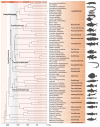Phylogenetic and Evolutionary Comparison of Mitogenomes Reveal Adaptive Radiation of Lampriform Fishes
- PMID: 37240101
- PMCID: PMC10218585
- DOI: 10.3390/ijms24108756
Phylogenetic and Evolutionary Comparison of Mitogenomes Reveal Adaptive Radiation of Lampriform Fishes
Abstract
Lampriform fishes (Lampriformes), which primarily inhabit deep-sea environments, are large marine fishes varying from the whole-body endothermic opah to the world's longest bony fish-giant oarfish, with species morphologies varying from long and thin to deep and compressed, making them an ideal model for studying the adaptive radiation of teleost fishes. Moreover, this group is important from a phylogenetic perspective owing to their ancient origins among teleosts. However, knowledge about the group is limited, which is, at least partially, due to the dearth of recorded molecular data. This study is the first to analyze the mitochondrial genomes of three lampriform species (Lampris incognitus, Trachipterus ishikawae, and Regalecus russelii) and infer a time-calibrated phylogeny, including 68 species among 29 orders. Our phylomitogenomic analyses support the classification of Lampriformes as monophyletic and sister to Acanthopterygii; hence, addressing the longstanding controversy regarding the phylogenetic status of Lampriformes among teleosts. Comparative mitogenomic analyses indicate that tRNA losses existed in at least five Lampriformes species, which may reveal the mitogenomic structure variation associated with adaptive radiation. However, codon usage in Lampriformes did not change significantly, and it is hypothesized that the nucleus transported the corresponding tRNA, which led to function substitutions. The positive selection analysis revealed that atp8 and cox3 were positively selected in opah, which might have co-evolved with the endothermic trait. This study provides important insights into the systematic taxonomy and adaptive evolution studies of Lampriformes species.
Keywords: Lampriformes; endothermy; mitochondrial genome; phylogeny; tRNA loss.
Conflict of interest statement
The authors declare that they have no competing interests.
Figures






References
-
- Jia W.Z., Yan H.B., Guo A.J., Zhu X.Q., Wang Y.C., Shi W.G., Chen H.T., Zhan F., Zhang S.H., Fu B.Q., et al. Complete mitochondrial genomes of Taenia multiceps, T. hydatigena and T. pisiformis: Additional molecular markers for a tapeworm genus of human and animal health significance. BMC Genom. 2010;11:1–13. doi: 10.1186/1471-2164-11-447. - DOI - PMC - PubMed
-
- Gong L., Shi W., Si L.Z., Kong X.Y. Rearrangement of mitochondrial genome in fishes. Dongwuxue Yanjiu. 2013;34:666–673. - PubMed
MeSH terms
Substances
Grants and funding
LinkOut - more resources
Full Text Sources

